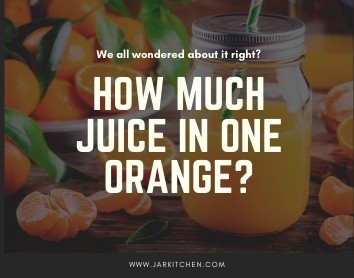Table of Contents
If you are a juice enthusiast, you sure love experimenting with orange juice recipes. The best thing is oranges are available round the year and are loved by all. That said, the number of these fruits required may vary according to various factors. So, how much juice in one orange?
First, it depends on the size of the oranges you buy, followed by its type. Some may be small and juicier, while others may be bigger and still contain less juice. Apart from that, the season makes a considerable impact on the juiciness of an orange.
Overall, there may be several factors that can determine the quantity of juice in one orange. When your recipe calls for ‘juice in 1 orange,’ how many oranges should you use? This article will gain insight into everything you need to know how much juice is in one orange.
Let’s dive in!
How Much Juice Is In an Orange?
Despite the various factors, an average orange may contain 4-5 tablespoons of juice. It makes up for 1/4th or 1/3rd of a glass. However, that also depends on the size of your glass. Clearing the confusion, one orange has almost 75-80 ml juice.
That said, you cannot always be sure about the exact quantity. Therefore, it is essential to consider a few determinants to find out the right amount of juice in one orange. Here is a list of the most common type of juicing oranges.
Navel Orange
It is the most common type of orange, easily found in the market. The distinctive quality of a navel orange is that it protrudes from the center or the apex. The extended part resembles the navel of a human, hence the name.
These oranges are rich in Vitamin C, which is beneficial for boosting immunity. Furthermore, it contains a high level of fiber and potassium, which is good for the heart as well as diabetes.
Size
(3-4 inches) Navel oranges are quite large as compared to other types. Additionally, they have relatively thick skin. Therefore, these oranges are easy to peel and preferable for consumption over other species.
Season
These oranges ripe during the winter, i.e., December to April. These are the best months for opting for these oranges as you will get the maximum amount of fresh juice. Irrespective of its ripening season, Navel oranges are available throughout the year.
Juice in one Navel Orange
Despite the large size, these oranges are less juicy. That may be due to their thick skin as well as fiber. However, a medium-sized navel orange can still give almost 3-4 tablespoons or 1/4th glass of juice.
Note: Navel oranges are usually bitter due to the high content of limonin in them. You may choose to add sugar or honey to enhance the flavor. That said, the Cara Cara navel oranges are pinkish-red in color, sweet and pulpy—perfect for juicing.
Another notable fact is that you must consume navel orange juice within 30 minutes. The presence of limonin makes it even more bitter over time.
Blood Orange
With a prominent crimson-colored flesh, blood oranges are highly attractive. They have a distinct raspberry-like flavor along with a sweet and tart-like taste, making them great for juicing and snacking. Additionally, they are one of the most aromatic types of oranges.
Apart from that, the blood orange has a notable amount of Vitamins B and C, adding to its juicing qualities.
Size
Blood oranges are medium-sized oranges without any seeds. Despite their thick skin, these oranges are quite juicy.
Season
Blood orange grows in a rather warm and temperate climate and ripens by November-December. Buying these oranges from December to April will give you enough fresh juice. It may dry up or lose the freshness beyond those months.
Juice in One Blood Orange
Blood oranges are one of the juiciest ones, where one orange gives 1/3rd glass or 80-85 ml of juice.
Note: Choosing oranges that have a dark, redder peel is better for juicing. They are sweeter and juicier. Also, blood orange juice can be easily stored for a few days without going bad.
Clementine
These are a smaller variety of oranges, more like a hybrid between mandarin and navel. These are seedless oranges and have a notably thin peel—thus, great for juicing. Additionally, clementine oranges are sweet and flavorful, giving an apricot-like taste.
What’s more? They make for a great source of Vitamin C. However, to prepare one cup, you would need several of these.
Size
Clementine oranges land somewhere between small and medium oranges. Therefore, they are not too tiny but smaller than usual. May be around 2-3 inches in size.
Season
A Clementine orange may ripe around December to January. It is best to juice these oranges from January to March.
Juice in One Clementine Orange
One Clementine orange contains a relatively less amount of juice, i.e., 2 tablespoons. Thus, if you need a glass of juice, approximately 7-8 clementine oranges would suffice.
Note: Despite its size, Clementine oranges are a good choice for juicing due to their flavorful taste and easy-to-peel thin skin.
Mandarin
Mandarin oranges fall under the smaller categories of oranges. Both tangerine and clementine belong to this family. Despite their small size, they are quite juicy and have a sweet taste. These oranges have less acidic content and are great for juicing and snacking.
Size
Almost 2 to 3 inches in size, these are the smallest group of oranges. You may think that the juice yield for these oranges may be too less due to their size. However, they have a thin peel and very few to no seeds, increasing the juice content.
Season
Mandarins ripe around January to February and are available throughout February to April (sometimes May).
Juice in One Mandarin Orange
You can easily extract 3 tablespoons of juice from one mandarin. That is, if you want to make a cup of mandarin juice, you would need 5-6 of them. It is more than clementine but certainly less than Navel, Blood orange, and other bigger species.
Valencia

Named after a city in Spain, Valencia orange is widely-used for preparing juices. It is one of the commonly-available species of the fruit and thus highly consumed. It has a sweet, tart-like taste and very few seeds, making it ideal for juicing. Additionally, it is rich in Vitamin C!
Size
Valencia oranges may range from 3 to 5 inches in diameter, making them medium to large in the category. It has a thin peel but a thick, white pith. Therefore, it may be a little difficult to peel.
Season
Widely named as the summer orange, Valencia is the only species of this fruit to ripe in summer. Therefore, it makes for the perfect orange juice during the warm season. Valencia oranges must be used throughout the summer months, starting from April to August for fresh juice.
Juice in One Valencia Orange
You can get almost 4-5 tablespoons of juice from a Valencia orange. If you want to make a cup of juice, you would need approximately three medium to large size oranges.
Note: Valencia is excellent for juicing and can give a considerable amount of juice. They are sweet, have a thin peel, and few seeds. However, they are difficult to peel due to the thick pith.
Tangelo
You may not have heard a lot about Tangelos, but they are one of the best oranges for juicing. It is a hybrid result of the Tangerine and Pomelo. They have a relatively looser skin that is pretty easy to peel and a nipple-like shape, making them different. Also, its taste is more on the tangy side.
Tangelos are rich in Vitamins such as A and C and nutrients like calcium, magnesium, and more.
Size
Though Tangerines are a smaller breed, Pomelos are undeniably large. As a result, a Tangelo has a fairly-medium size, as big as a human fist. Thus, it can give a considerable amount of juice.
Season
The hybrid breed ripens around April and is usually available until June-July. It is the best orange to choose for the summer months for cocktails and flavorful juices!
Juice in One Tangelo Orange
One Tangelo can easily give around 3/4th glass of juice. Isn’t that great? It makes for 10-12 tablespoons of juice.
Note: Tangelo has a juicy flesh, thinner peel, and is medium-sized, resulting in the maximum amount of juice per orange.
Which Orange Has the Maximum Juice Content?
Having gone through the varying types of oranges, you know the exact juice content in one orange based on its type. Here is a table summarizing the amount of juice in one orange.
How much juice in one orange (based on the type of orange)
| ORANGE TYPE | JUICE IN ONE ORANGE (tbsp) | JUICE IN ONE ORANGE (ml) | JUICE IN ONE ORANGE (cup) | Size (inches) | Season |
| Tangelo | 10 – 12 | 180 – 190 | 3/4th | 3-5 | April to July |
| Blood Orange | 5 – 6 | 80 – 85 | 1/3rd | 3-4 | December to April |
| Valencia | 4 – 5 | 60 – 80 | 1/4th | 3-5 | April to August |
| Navel | 3 – 4 | 50 – 70 | 1/4th | 3-4 | Round the year |
| Mandarin | 3 | 40-50 | 1/5th | 2-3 | February to April |
| Clementine | 2 | 30 – 40 | 1/8th | 2-3 | January to March |
Based on the given table, it is visible that Tangelo has the highest juice content among all. However, Valencia is the most easily available orange, thus exceeding Tangelo and Blood orange.
If you want to learn more about the nutritional facts about Orange Juice, we suggest that you take a look at Wikipedia.
How Many Oranges Are Enough for One Glass of Juice?
By now, you are aware that you cannot get the same amount of juice from every orange. On average, you will need 3 medium-sized oranges to get a glass full of juice. However, it will vary according to the different species.
Here is a list explaining the number of oranges required to make one glass of juice that measures 250 ml.
- Tangelo: 1.5 oranges = 1 glass (or more)
- Blood Orange: 3 oranges = 1 glass
- Valencia: 3-4 oranges = 1 glass
- Navel: 3-4 oranges = 1 glass
- Mandarin: 5-6 oranges = 1 glass
- Clementine: 7-8 oranges = 1 glass
Maximizing how much juice in one orange you can get.
Varying orange-types bear distinctive quantities of juice. However, you may not be able to fully extract every drop by squeezing or even through a machine. That said, if you follow a few simple techniques, you can get the maximum juice content available in orange.
Roll the Orange
While you may think too soft oranges may have spoilt, firm oranges mean they are fresher. However, if orange is too rigid, it may still not have fully ripened. Irrespective of that, you must roll the orange over a hard base.
You may choose to do so on the kitchen counter or a chapping board. It will make the fruit softer. Moreover, it will let you juice the orange easily, allowing you to extract the maximum amount of juice possible.
Note: Roll one orange at a time on your countertop to properly soften each of them. Make sure you do not press it too hard that the peel tears off.
Choose an Efficient Electric Juicer
Some people may opt to juice their oranges through a hand-juicer, while others may go ahead and squeeze them directly. Though these techniques can successfully extract orange juice, you may not get all the juice present in an orange. You will have to put in a lot of effort into getting a fraction of juice.
On the other hand, an electric orange juicer can do all that work within seconds. The best thing is it will extract every drop of juice present in the orange. Though it may be a little pricey, it is worth the investment if you drink orange juice daily.
Such juicers are designed especially for juicing oranges and are pretty easy to use. All you need to do is place the pieces of oranges over the cones and close the lid. Your juice will be ready within seconds. That said, you can still choose to go for a hand juicer as it is cheaper and occupies less space.
If you are looking to buy an efficient electric orange juicer, be sure to read our Best Orange Juicer Reviews!
Warm Up the Orange
You may not have heard of this technique before, but it works! It is limited to orange, but every fruit can yield a higher juice content if it is warm. When the orange is cold, the juice may be thicker, and thus, it is more difficult to extract each drop.
You must know that warming the fruit does not mean you need to roast or cook it. All you got to do is put it in a microwave for about 10-15 seconds. However, make sure that you remove the peel before placing it in the microwave.
Alternatively, you can roll the fruit between your hands. Though this may warm-up the orange a little, it is not as effective as the previous method.
With a warmer orange, you can get the maximum juice possible without any effort. It is so because this helps break the membranes of an orange that hold the juice.
Cut Smaller Pieces
You may be wondering if that is helpful. It is! If you cut an orange into quarters rather than cutting them into halves, you can extract more juice. The method is especially useful if you plan to squeeze the oranges or juice with a hand-juicer.
A quarter or a smaller piece of orange is easy to squeeze and yields more juice than otherwise. Moreover, this way, you can also remove the seeds without much effort.
How much juice in Maximum Juice?

First of all, to be able to know how much juice is in one orange, you need to eliminate other factors first. One of those factors is to know how to choose an orange for maximum juice.
Oranges are rich in Vitamins and nutrients and have a superb taste, making them a favorite of all. Grabbing a glass of orange juice for breakfast or other meals is perfect for sufficing your daily nutrient-requirement.
You will get a plethora of packaged juices in the market that can save you from all the effort of juicing. However, that is not the wisest option. It has multiple additives and high sugar content that ruins the juice’s entire point of being a healthy option.
Apart from that, getting a glass of freshly-squeezed juice from a restaurant or a stall is an option. Yet again, it is not the best choice as you never know the exact contents of the juice. It may be high in calories and not 100% organic.
That leaves you with the option of juicing oranges at home. Though it requires a little effort, it is completely worth the healthy and nutrient-rich juice. However, you must keep a few things in mind while purchasing oranges for juicing. That is, choosing the juiciest orange.
To be able to decide how much juice is in an orange, here are a few things to look into for the juiciest oranges.
Thin Peel
Thin peel is one of the most important things while trying to understand how much juice is in orange. Though your first choice would be a big orange, such pieces usually have a thick peel. Thus, the whole point of being large is gone in vain. An orange with a thinner cover is easy to peel and also has a higher juice content.
Fewer Seeds
If you have an electric juicer, the seeds of orange may not be an issue as they can be filtered. However, in a hand juicer as well as by squeezing the orange, you will have to remove them yourself. Therefore, it is better to look for oranges that have a few to zero seeds. It also means the juice content will be higher.
Less Pith
Some oranges have a thick, white-colored pith. Though it is healthy as it is rich in fiber, it results in orange with less pulp. Moreover, removing the pith can be a time-taking process. Thus, you must look for an orange that has a thinner layer of pith.
Heavy
Heavier oranges directly mean a higher content of an orange. That is why before buying an orange for juicing, it is wise to weigh it in your hands itself. That said, a higher weight can also be due to the thickness of the peel. It is best to test a few oranges before buying a large batch.
Bright and Glossy Peel
The freshness of orange is reflected through its skin. If the orange is in the season, you can easily get your hands on a glossy batch. Make sure that the cover is bright-colored and doesn’t show traces of spoilage.
The freshness considerably impacts the juice content in an orange. If you buy oranges that aren’t fresh, they may have dried-up, resulting in less juice (obviously).
Type of Orange
All of the other factors add up to the type of orange you choose. The orange species can determine its size, a number of seeds, the thickness of peel, the pith—each aspect. Refer to the table above that shows the amount of juice in one orange as per the kind.
FAQs
- How long can I store orange juice?
All types of oranges contain an antioxidant—Limonin, in varying amounts. While it is beneficial for boosting immunity and killing cancerous cells, it is quite bitter. Once an orange is juiced, this compound starts to break down, increasing the bitterness of the drink.
That is why you must consume orange juice within 30 minutes of squeezing. However, some oranges have limonin in their seeds, thus staying sweet for a prolonged period.
If you are looking for storing orange juice for a prolonged period, you can do so in an air-tight container. You can leave it in the freezer for up to a month, as the container will maintain the freshness.
- Can I include the orange peel in the juice?
Orange peels are rich in nutrients, serving to be beneficial for hair, skin, digestion, and much more. That is why some people would like to add it to their juice. However, they can be highly bitter, ruining the taste.
More importantly, orange peels may contain harmful chemicals as well as viruses despite being washed. Therefore, it is best to peel your orange before juicing.
Conclusion on how much juice in one Orange…
Orange juice is a delicious way of taking in some essential nutrients on a daily basis. However, it is best to prepare it at home itself, control the calorie intake and hygiene. That is why choosing the right oranges for juicing is significant.
This article gives you a detailed insight into how much juice is in one orange. Also, you learn about the various types of oranges and their juice content. Now you are completely ready to buy the best type and the most accurate number of oranges and finally have the answer to your query: “How much juice in an orange”
Go and rock your favorite orange juice recipe!

This is Berk from the JarKitchen Team. I am a Mechatronics Engineer and I like cooking in my spare time. By bringing my engineering background into the business, product reviews are a specialty for me. During my travels across Europe, I have learned/tested many recipes and now I plan to bring them to you here!






